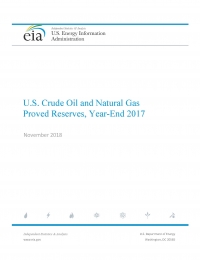EIA: U.S. Crude Oil and Natural Gas Proved Reserves - Year-end 2017 - eng (pdf)
Stronger oil and natural gas prices combined with continuing development of shales and low permeability formations drove producers of crude oil and natural gas in the United States to report new all-time record levels of proved reserves for both fuels in 2017. Total U.S. oil reserves in 2017 exceeded a brief, one-year, 47-year-old record, highlighting the importance of crude oil development in shales and low permeability plays, mainly in the Southwest. The new record for natural gas extends a longer-term trend of development, mainly in shale plays in the Northeast. Both U.S. proved reserves of crude oil and natural gas are approximately double their levels from a decade ago. These new proved reserves records were established in 2017 despite production of crude oil at levels not seen since 1972, and record natural gas production.
Highlights are listed below.
Oil highlights
- Proved reserves of crude oil in the United States increased 19.5% (6.4 billion barrels) to 39.2 billion barrels at Year-End 2017, setting a new U.S. record for crude oil proved reserves. The previous record was 39.0 billion barrels set in 1970.
- Proved reserves of lease condensate in the United States increased 16% (0.4 billion barrels) to 2.8 billion barrels at Year-End 2017. Since 2009, to provide a clearer picture of U.S. liquid fuel resources, EIA features combined proved reserves of U.S. crude oil and lease condensate in its reporting.
- U.S. production of crude oil and lease condensate increased by 6% from 2016 to year-end 2017. Crude oil production in 2017 reached its highest level since 1972.
- The annual average spot price for a barrel of West Texas Intermediate (WTI) crude oil at Cushing, Oklahoma increased 20% in 2017, from $42.59 in 2016 to $51.03. At the end of 2017, the WTI spot price exceeded $60 per barrel for the first time since June 2015.
- Producers in Texas added 3.3 billion barrels of crude oil and lease condensate proved reserves, the largest net increase of all states in 2017. The increase was a result of increased prices and development in the Permian Basin of the Spraberry Trend and the Wolfcamp/Bone Spring shale play.
- The Wolfcamp/Bone Spring shale play in the Permian Basin surpassed the Bakken/Three Forks play in the Williston Basin to become the largest oil-producing tight play in the United States in 2017.
- The next largest net gains in crude oil and lease condensate proved reserves in 2017 were in New Mexico (1.0 billion barrels) and in the Federal Offshore Gulf of Mexico (729 million barrels).
Natural gas highlights
- Proved reserves of natural gas increased by 123.2 trillion cubic feet (Tcf) (36.1%) to 464.3 Tcf at year-end 2017—a new U.S. record for total natural gas proved reserves. The previous U.S. record was 388.8 Tcf, set in 2014.
- U.S. production of total natural gas increased by 4% from 2016 to 2017, reaching a new record level.
- The share of natural gas from shale compared with total U.S. natural gas proved reserves increased from 62% in 2016 to 66% at year-end 2017.
- The annual average spot price for natural gas at the Louisiana Henry Hub increased by 21% from $2.47 per million British thermal units (MMBtu) in 2016 to $2.99 per MMBtu in 2017.
- Producers in Pennsylvania added 28.1 Tcf of natural gas proved reserves, the largest net increase of all states in 2017, as a result of increased prices and development of the Marcellus and Utica shale plays.
- The next largest net gains in natural gas proved reserves by volume in 2017 were in Texas (26.9 Tcf) and Louisiana (18.4 Tcf) as a result of development of the Wolfcamp/Bone Spring shale play in the Permian Basin and the Haynesville/Bossier shale play in eastern Texas and northern Louisiana.
Proved reserves are estimated volumes of hydrocarbon resources that analysis of geologic and engineering data demonstrates with reasonable certainty[1] are recoverable under existing economic and operating conditions. Reserves estimates change from year to year as new discoveries are made, as existing fields are thoroughly appraised, as existing reserves are produced, as prices and costs change, and technologies evolve.
To develop this report, EIA collects independently developed estimates of proved reserves from a sample of operators of U.S. oil and natural gas fields from its survey Form EIA-23L, and then estimates the non-reported portion of proved reserves. Responses were recerived from 412 of 418 sampled operators. Estimates are developed for the United States, each state, and state subdivisions. Within this report, EIA publishes proved reserves for state subdivisions within California, Louisiana, New Mexico, Texas, and the Federal Offshore Gulf of Mexico.
Дополнительная информация
- Серия: Госорганы / Зарубежные / EIA / U.S. Crude Oil and Natural Gas Proved Reserves
- Год: 2017
- Месяц: 12 (год)
- Источник: EIA


































